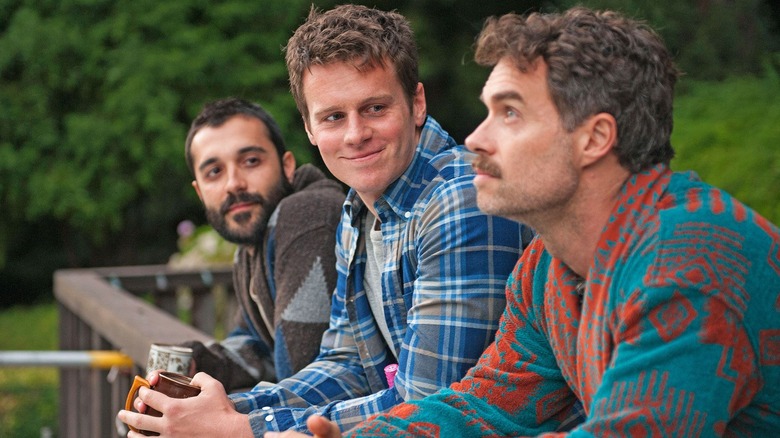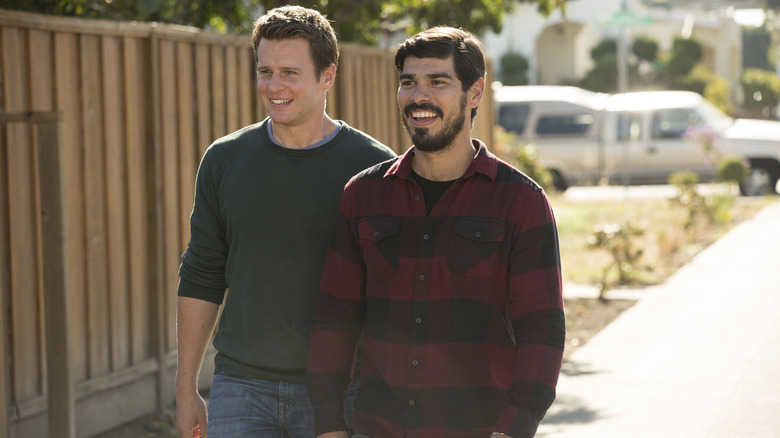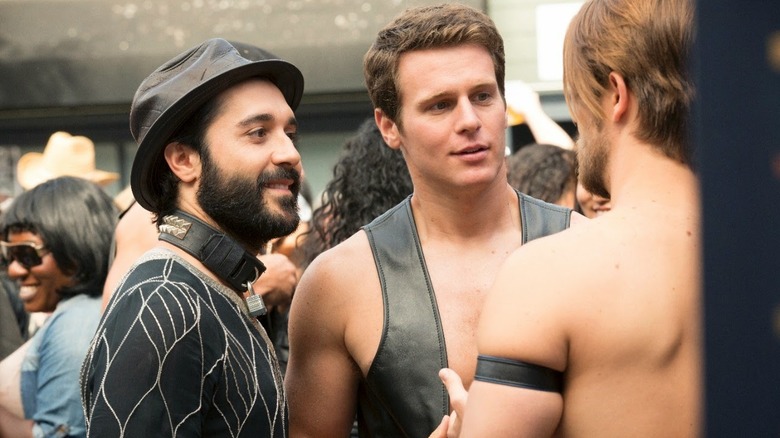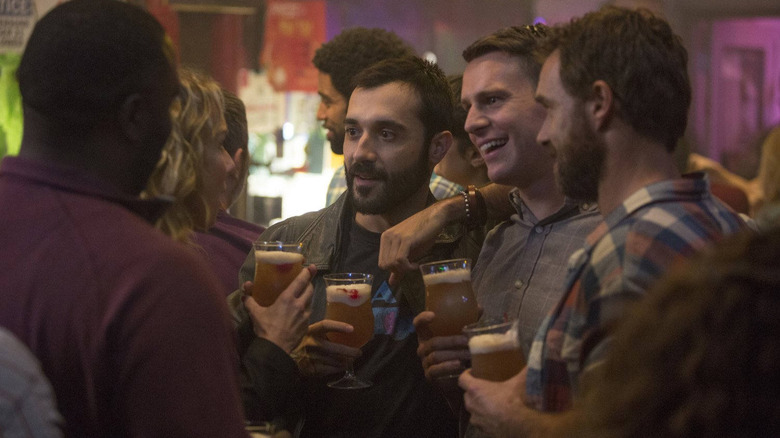The Daily Stream: With Looking, HBO Found A Touchstone Queer TV Series
(Welcome to The Daily Stream, an ongoing series in which the /Film team shares what they've been watching, why it's worth checking out, and where you can stream it.)
The Series: "Looking"
Where You Can Stream It: HBO Max
The Pitch: There's a specific malaise that comes with being in your 30s. In your 20s, bouncing around from one job to the next or failing to sustain a lasting romantic relationship can be a source of great anxiety, yet you can always assure yourself that tomorrow will be better. But by the time you're a tricenarian, you become far more aware of just how much time is slipping through your fingers like grains of sand, and you're forced to reconcile the reality of your life with the one you imagined yourself having in the future.
When "Looking" debuted on HBO in January 2014, my 30s were right around the corner, much as they are for Patrick (Jonathan Groff) when the series begins. Like Patrick, I was comfortably established in my career by then; in the former's case, he's a video game designer living his best life in the gay mecca that is San Francisco with his best friends, Agustín (Frankie J. Alvarez) and Dom (Murray Bartlett). However, after a very brief, and very awkward, meet-up with an OkCupid date in the first episode, it becomes painfully clear just how ungainly Patrick is when it comes to his love life. Agustin, on the other hand, finds his dreams of being a successful artist pulling away upon moving in with his boyfriend. As for Dom? At 39, he's the oldest of the three, and has come to realize his life of waiting tables and casual hook-ups is simply no longer fulfilling.
All three are "looking" for something ... but what, exactly?
Why it's essential viewing
Created by Michael Lannan and based on his 2011 short film "Lorimer," "Looking" speaks to the omnipresent struggle of not only trying to lead the adult life you want to have but also figuring out what that even is once the roller coaster ride of yours 20s is behind you — and learning to accept that it might never be exactly what you want. That it does so through a specifically queer lens affords "Looking" a universality that it would've otherwise lacked, had it tried to cater to a bigger audience (which, in this case, is a polite way of saying "the straights") with its subject matter and relationship drama.
More than that, the show is keenly aware of its leads' individual shortcomings. Patrick's naivety is practically designed to leave you cringing, especially when he finds himself at the center of a love triangle comprised of his adorable boyfriend Ricardo/Richie — played by "The Inspection" actor Raúl Castillo, whom I have a permanent crush on thanks to his tender performance here — and Pat's boss Kevin (Russell Tovey), a kindred spirit who's already in a long-term relationship when the pair cross paths. (Can you tell I'm #TeamRichie?) In the same way, Agustin's snarky manner and selfish behavior made him the bane of many "Looking" fans' existence in season 1, yet you never get the impression that's on accident. And if you loved Murray Bartlett as Frank in "The Last of Us," it's easy to pretend Dom is a younger version of the character, complete with his knowledge of fine wines and his knack for recognizing precisely how to charm people. That he's also overly dependent on his lifelong friend Doris (Lauren Weedman), and vice versa, speaks to his own stunted emotional growth.
Queer sex and the city
The show's commitment to honesty and authenticity extends to its creatives, many of whom worked on "Looking" shortly before becoming much bigger names. Among those who collaborated with Michael Lannan on the series are directors and fellow queer storytellers Andrew Haigh ("45 Years") and Jamie Babbit ("But I'm a Cheerleader"), as well as queer multi-hyphenates such as Allan Heinberg ("The Sandman"), "Vida" creator Tanya Saracho, "Only Murders in the Building" co-creator John Hoffman, and Archie Comics Chief Creative Officer Roberto Aguirre-Sacasa (creator of "Riverdale" and "Chilling Adventures of Sabrina").
Its naturalistic aesthetic only further befits "Looking" and the unvarnished, candid narrative portrait it paints of its characters and their world. From the handheld camerawork to its reliance on environmental lighting, the show's version of San Francisco is one that feels so palpable and tactile that it doesn't take much to pretend you're there alongside Pat and the gang, taking in the city's lively nightlife or basking in the rays of sun that poke their heads through the cloudy daytime skies. Days and nights blur into one another through the show's concise edits, much in the same way they do once you reach a certain point in your adult life.
When it comes to realism, though, few elements of "Looking" stand out quite as much as the show's frank and vulnerable yet never exploitive sex scenes. The show was rightly commended for correcting common misperceptions about queer male sex at the time, including (in perhaps the show's most radical subplot) that it's possible for HIV-positive men to have safe sex with their partners. But its ultimate goal was to "illuminate male intimacy in sex and in general [...] by finding moments that felt real and true to life," as Jonathan Groff once put it (via Out).
An abbreviated but satisfying conclusion
Having more in common with acclaimed romantic hangout dramas like Richard Linklater's "Before" trilogy and Andrew Haigh's 2011 film "Weekend" than a soapier 2SLGBTQ+ landmark series such as "Queer as Folk" (not that there's anything wrong with being soapy), "Looking" never really seemed all that invested in presenting itself as appointment TV. And while that probably hurt its ratings in the long run, those who did tune in to watch it week after week, like yours truly, were able to deeply engage with the show's profoundly subtle character work and gently captivating drama. That and the parade of charismatic character actors playing love interests for the leads, including Scott Bakula ("Quantum Leap"), Bashir Salahuddin ("GLOW"), and Daniel Franzese ("Conviction").
After two seasons, "Looking" wrapped up with the 85-minute "Looking: The Movie" on HBO in 2016. As you would expect, the film was equivalent to a truncated version of what a third season might've entailed, yet it still managed to bring a greater sense of closure to the show's dangling plot threads. Although, as was also the case with the network's "Deadwood," the series proper ended on an unexpectedly perfect note, which made the subsequent movie more of a touching epilogue than an absolutely vital piece of the greater storytelling puzzle.
Looking back, I would venture so far as to say "Looking" helped me navigate my own existential uncertainty as a queer 30-something, and the relatively open-ended nature of its conclusion was a major part of that and felt true to the show's defining ethos. Just as our lives never stop changing, we never truly stop "looking" for a better peace of mind or sense of purpose. But with the right people by our sides, we might just find the path we need to move forward.



